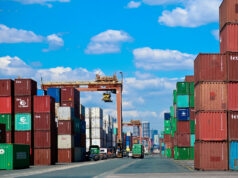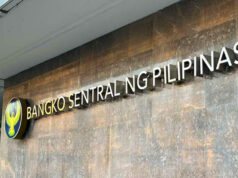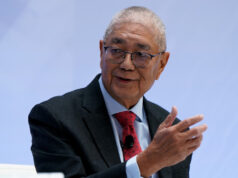Inflation slows in March
THE overall rise in prices of widely used goods and services eased in March, the Philippine Statistics Authority (PSA) reported on Tuesday.
March saw headline inflation slow further to 2.5% from 2.6% in February and 3.3% a year ago, preliminary PSA data showed.
The March result was higher than the 2.3% median in a BusinessWorld poll conducted late last week and falls within the 2-2.8% estimate given by the Bangko Sentral ng Pilipinas (BSP) for the month.
So far, headline inflation averaged 2.7%, still within the BSP’s 2%-4% target band for the entire 2020.
Core inflation, which discounted volatile prices of food and fuel, stood at three percent in March, slowing from 3.2% the previous month.
“The slowdown in inflation in March 2020 was primarily due to transport, whose index dropped at an annual rate of 1.8% [from a growth rate of 1.8% in January]. Slower annual increments in the indices of alcoholic beverages and tobacco at 18% [from 18.2%]; housing, water, electricity, gas, and other fuels at 1.1% [from 1.8%], also pushed down the inflation during the month,” the PSA said in a statement.
On the other hand, indices that saw faster annual markups were food and non-alcoholic beverages (2.6% from 2.1%); furnishing, household equipment and routine maintenance of the house (4.2% from 3.5%); communication (0.5% from 0.4%); and recreation and culture (1.6% from 1.5%).
The food-alone index also went the opposite direction as it accelerated by 2.6% in February from 2.1% in January, albeit slower than the 3.1% a year ago.
Driving food inflation were fish and fruits, which saw higher annual rate increases of 10.5% in February (from 8.6% in January), and 9.9% (from 8.5%), respectively. Other food commodities that accelerated during the period were vegetables (8.1% from 7.8%), food products “not elsewhere classified” (7.1% from 6.5%), and oil and fats (1.3% from one percent).
Notable food groups that either declined or decelerated were rice (-5.8% from -6.3%); corn (-3% from -2.3%); sugar, jam, honey, chocolate and confectionery (-1.2% from -1.7%); meat (2.6% from 2.9%); and other cereals, flour, cereal preparation, bread, pasta, and other bakery products (2.6% from 2.7%).
By region, the headline inflation in Metro Manila was lower than the national rate at 1.7%, easing from February’s two percent. Other regions where inflation was lower than the national average were Calabarzon (2.3%), Eastern Visayas (2.2%), Northern Mindanao (two percent); Davao Region (2.2%); and Bangsamoro Autonomous Region in Muslim Mindanao (2.3%).
Likewise, the PSA reported preliminary figures for inflation as experienced by low-income families for March. That month, inflation for the bottom 30% of income households grow by 2.4%, faster than the 2.2% in February, but slower than 3.5% in March 2019.
The CPI for the bottom 30% reconfigures the model basket of goods in order to reflect the spending patterns of the poor. This compared to the headline CPI which measures inflation as experienced by the average household.
RISKS AND OUTLOOK
According to ING Bank N.V.-Manila Branch Senior Economist Nicholas Antonio T. Mapa, March slowdown — albeit faster than the consensus — after food prices went up despite the government price freeze.
“Food items not covered by the government directive had prices pick up on reports of a pickup in grocery purchases, ostensibly ahead of the enhanced community quarantine (ECQ),” he said in an e-mail.
“Meanwhile, after the implementation of the ECQ, supply chain disruptions may have been noted both on delivery (increased checkpoints and required passes) and production as Luzon and most of the country is in some form of a lockdown. Demand for basic goods and commodities are in high demand, nudging prices higher,” he added.
Prices of basic goods were frozen from March 16 to May 15, following President Rodrigo R. Duterte’s declaration of a six-month state of calamity on March 16 in response to the outbreak of the coronavirus disease 2019 (COVID-19).
An initial price freeze was put into place after a declaration of public health emergency on March 8.
Despite this, the BSP said in a statement the latest inflation print is consistent with its assessment that “inflation is expected to be benign over the policy horizon due to the potential adverse impact of COVID-19 on the domestic and global economic environment.”
The central bank reiterated its assessment during last week’s monetary policy meeting last week wherein the risks to the inflation outlook “now leans toward the downside for both 2020 and 2021.”
“The uncertainty over the strength and duration of the pandemic poses significant downside risks to aggregate demand…,” the BSP said.
To recall, the central bank cut rates by 75 basis points (bps) this year through the 25-bp cut in February and another 50-bp cut done in March. This has brought down the overnight reverse repurchase, lending, and deposit rates to 3.25%, 3.75%, and 2.75%, respectively.
Meanwhile, the reserve requirement ratio (RRR) of universal lenders has been effectively reduced by 200 bps last Friday to 12% to give the financial market a liquidity boost amid the enhanced community quarantine (ECQ) currently imposed in Luzon.
LOWER IN APRIL
In a mobile phone message, BSP Governor Benjamin E. Diokno said inflation in April is “likely to be even lower” with the collapse of global oil prices, the freeze on necessities and the “zero or near-zero” increase in utilities.
“[T]he Philippines has ample monetary and fiscal space to overcome whatever adverse impact the pandemic has on the Philippine economy. BSP has already displayed what it can do to soften the potential economic slowdown,” Mr. Diokno said.
“[W]e survived the collapse of the economy in 1984 and 1985 when the economy contracted by [seven percent for two consecutive years] under a high inflation regime. Fast forward: the Philippine economy is much stronger and vibrant now than ever before — stable peso, hefty gross international reserves, robust and well-capitalized bank industry, manageable debt-to-GDP ratio, [and a] well managed fiscal policy with higher allocation for public infrastructure,” he added.
Meanwhile, Socioeconomic Planning Secretary Ernesto M. Pernia said in a statement that it is important for the government to implement seamless delivery of necessities and strict enforcement of price control measures “to avoid possible profiteering of unscrupulous traders and retailers.”
“We need to provide post-harvest facilities and logistic support, in close coordination with the local government. Initial field reports show that supply, particularly of agricultural commodities, is adequate but suppliers are having problems getting their produce to the market, to help affected essential industries produce and deliver their goods and services to the market,” Mr. Pernia, who is also the National Economic and Development Authority’s director-general, was quoted as saying.
JPMorgan Chase Bank NA Singapore Branch Economist Nur Raisah Rasid said the Philippines’ inflation trajectory “looks to remain benign” with headline inflation “likely averaging” 2.1% year on year, which is just slightly above the central bank’s lower bound of its 2%-4% target range.
“In terms of policy response, in our view, the lower inflation trajectory and recent easing of external monetary conditions have opened room for policy easing in the Philippines. Thus, we continue to expect further monetary policy support in the near term (25-bp cuts in each of the forthcoming Monetary Board meetings this quarter — May 21 and June 25), bringing the policy rate to 2.75% by end-2020,” she said in a note sent to reporters.
For Security Bank Corp. Chief Economist Robert Dan J. Roces, the result “gives the BSP additional room for more accommodative monetary policy.”
“For April, we expect prices to be pulled lower with really low world oil prices plus the price freeze on basic goods and steady cost of utilities,” he said in an e-mail.
In a separate e-mail, Sun Life Financial Economist Patrick M. Ella said the full impact of the price freeze will likely be seen for the April inflation result.
“April [inflation] will likely be closer to two percent, but this is still more of a guess than an estimate… For full-year, we are seeing a 2.3% inflation rate,” Mr. Ella said. — Lourdes O. Pilar, with inputs from Luz Wendy T. Noble



